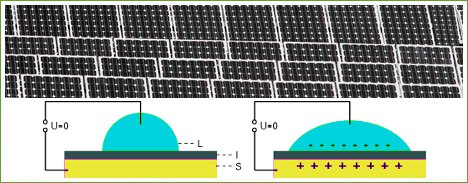|
What Is Electrowetting? Will it Boost PV Panel Efficiency?
Electrowetting might not be a term or a concept you are familiar with yet, but it is the principle behind optofluidic solar concentration, another one of the recent ARPA-E grants to improve efficiency in solar energy.
Electrowetting is the principle where a liquid changes from beading up on a surface to flattening out, based on the application of an electric charge. Instead of needing a cumbersome system to track the sun, this will allow a thin layer on top of the photovoltaic material to track the sun without any moving mechanical parts. The following illustration may help: 
As the shape of the liquid changes shape, so does the angle of the light hitting the photovoltaic cell. The goal, of course, is to increase the electrical output of the solar panel, by changing the shape of fluid to maximize the light striking the photoelectrical material at all times during the day. Because this is a fluid based system – it can therefore track the light on a dual axis basis for higher efficiency.
The oticalfluidic behavior of mercury and other liquids on variably charged surfaces was probably first explained by Gabriel Lippmann in 1875 and was certainly observed much earlier. Froumkin used surface charge to change the shape of water drops in 1936. The term electrowetting was first introduced in 1981 to describe an effect proposed for designing a new type of display device.
An unmoving solar panel has its greatest efficiency when it is pointing directly toward the sun, and power production drops off significantly as the sun's angle becomes more and more oblique. Motors, actuators, and other mechanical control systems can be used to track the sun and keep the panels in optimal orientation. But these are expensive and require far more maintenance than do just the solar panels themselves. There have been several attempts to focus more light on the solar panels during the day – such as fresnel lenses, prisms, etc. all with a certain degree of success. Not only are these type of variable controlled wetting systems likely to require less maintenance, they also require less energy for operation than mechanically moving the entire system, making them less parasitic of the power produced by the solar collector in the first place. Quieter, more reliable operation will also be a benefit for residential applications.
Teledyne Scientific & Imaging in partnership with the University of Maryland (winner of a ARPA-E grant) are researching a system that will use an "electrowetting-based dynamic liquid prism" to focus the sun for concentrating solar collectors. As the ARPA-E information describes the system: The optofluidic effect controls the contact angle of a liquid on a hydrophobic surface through the application of an electric field. With two immiscible fluids in a transparent cell, they can actively control the contact angle along the fluid-fluid-solid tri-junction line and hence the orientation of the fluid-fluid interface via electrowetting. The naturally-formed meniscus between the two liquids can function as an optical prism. Without any mechanical moving parts, this dynamic liquid prism allows the device to adaptively track both the daily and seasonal changes of the Sun’s orbit, i.e., dual-axis tracking.
As of October 22, 2010: Research work is ongoing. There are no published results yet indicating the effectiveness of this technological approach. Back from this page on Electrowetting to our lead page on Solar Research
|


